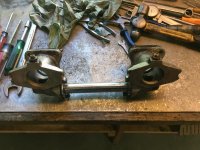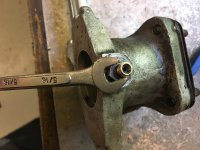Offline
I recently sent my H6 carbs and intake manifolds off to Tom Bryant for refurbishing. Tom just contacted me asking what was the purpose of the nipples on bottoms of the manifolds (see pictures). I told him that there is a 12 or so inch long copper tube (not shown) attached to each nipple running down past the exhaust manifold.
This is the way the car came to me in 1999. The car was converted to M specs in 1957 by the first owner and I have always assumed these tubes were a part of the M conversion. Tom questions why the fuel system would be vented to atmosphere and though I have wondered about this myself I never thought to investigate further. He is recommending I plug the holes and I agree--at best the tubes make R&R-ing the carbs that much more difficult.
Any input will be appreciated.
This is the way the car came to me in 1999. The car was converted to M specs in 1957 by the first owner and I have always assumed these tubes were a part of the M conversion. Tom questions why the fuel system would be vented to atmosphere and though I have wondered about this myself I never thought to investigate further. He is recommending I plug the holes and I agree--at best the tubes make R&R-ing the carbs that much more difficult.
Any input will be appreciated.

 Hi Guest!
Hi Guest!

 smilie in place of the real @
smilie in place of the real @
 Pretty Please - add it to our Events forum(s) and add to the calendar! >>
Pretty Please - add it to our Events forum(s) and add to the calendar! >> 



